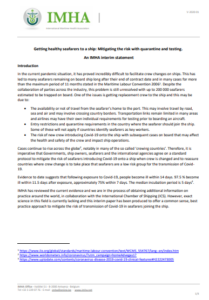Amid the the current pandemic situation which has adversely affected the ability of crew changes, the International Maritime Health Association (IMHA) shared recommendations on quarantine and testing requirements for seafarers joining a ship.
The pandemic has led to many seafarers remaining onboard, long after their end of contract date and in many cases for more than the maximum period of 11 months stated in MLC 2006. Despite the collaboration of parties across the industry, this problem is still unresolved with up to 200,000 seafarers estimated to be trapped onboard.
Therefore, as a gold standard, IMHA recommends that all seafarers leaving their home country to join a ship should be tested before they travel to the port of joining.
[smlsubform prepend=”GET THE SAFETY4SEA IN YOUR INBOX!” showname=false emailtxt=”” emailholder=”Enter your email address” showsubmit=true submittxt=”Submit” jsthanks=false thankyou=”Thank you for subscribing to our mailing list”]
Upon arrival in the port where they are to join a ship, seafarers should quarantine for 2 weeks in suitable accommodation, preferably ashore, arranged and paid for by the shipping company. Seafarers should be tested at Day 3 to 5 after arrival in country and at the end of this period of quarantine.
If quarantine in the port or country of joining a ship is not possible, seafarers may quarantine for 2 weeks in their home country, prior to travel. This can either be at home, if appropriate, or in accommodation arranged and paid for by the shipping company. Again testing should be done at the beginning and end of this quarantine period prior to travel.
Once the seafarers have arrived in the country where they will join their ship, they should be tested again if they are not going to join the ship for 3 to 5 days. If they are to board within 3 days of arriving in a country this test is probably not worthwhile. If no further test is possible (or the result is not available), the seafarer should follow shipboard self-distancing (SSD) for the first 14 days on board or until a negative test result is available.
When seafarers are travelling at any time, they should avoid others as much as possible. Handwashing, physical distancing and good respiratory etiquette must be observed and a medical facemask may be advised.
Whilst 14 days of quarantine is advised, it may be very difficult to facilitate particularly in crewing patterns with a leave period of just a couple of weeks.
A quarantine period of 10 or even 7 days is accepted in some countries when combined with two separate tests and self-reporting of symptoms.
A reduction of the quarantine time must be part of a full risk assessment of the crew change policy and an approval by a competent authority or person.
Irrespective of policy, if any of the tests are positive or the seafarer develops any symptoms suggestive of Covid-19, the seafarer should receive treatment as appropriate and must not join the ship until they are considered free of the virus and non-infective to others.
Unpublished data from one clinic has found that 1% of tests done in seafarers planning to join a ship were positive and these seafarers were successfully prevented from travelling to, and joining, the ship.
Find out more herebelow:


































































if a joining seafarer having been identified with positive covid results then later brought to an isolation center. after 10 days
having found no covid symptoms whats the next step to be done to the seafarer?, is he going to be re-swab? , send home for further osolation? or can he simply live and join the commmunity and of course following minimum health protocols? just asking.. thank you